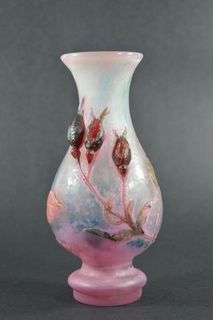Emile Gallé’s factory had two types of production : prestige parts and « mass production » parts. It’s really necessary to know how to distinguish them.
Emile Gallé’s glass objects, vases or lamps, are frequent at public sales and antique dealers.
But why are the prices variable, from the simple to the tenfold, often 2,000€, sometimes 20,000€ and up to 300,000€?
(See our example sold 120 000€).
It is important to know that this very wide price range is totally justified because Gallé has had 2 types of production of its glassware.

Picture above : Emile Gallé, Vase Roses of France in buttons
Multilayer glass with interlayer marbling imitating agate.
The belly is decorated with three ruby red rosebuds in application, resumed with the wheel. The stems and leaves are made of hot-applied glass and glass plates chiselled with the wheel and the grinding wheel.
The decoration stands out on a background taken again in hammering.
Signature in reserve engraved with the grinding wheel. Height 19.3 cm.
Sold 120 000 € by the company CAMARD in Drouot on March 25, 2013.
Plan – Here are some elements for :
-make the difference between these two productions,
-make the difference between pieces made during Gallé’s lifetime and posthumous pieces.
Then will come some remarks about the false Gallé.
Reminder: Gallé’s production is composed only of blown or blown-molded glass and NOT glass paste.
Who is Emile Gallé (1846-1904) ?
Emile Gallé, is above all a draftsman, designer and editor of glassware, ceramics and furniture.
His other activities: inventor of technical processes, company manager, promoter of crafts and art industry in the Nancy region.
(Creation of the Association de l’École de Nancy or Alliance Provinciale des Industries d’Art in 1901).
His fields: glass and ceramics then cabinet making.
His inspiration: nature, the Symbolist movement, Japanese art.
His style: He is one of the greatest creators of the Art nouveau movement. His father was a model creator for ceramics and was honored with the title of « supplier of the Emperor » for glass objects in 1866. Emile Gallé began around 1870 in
He was very young at the time, and he was able to « pencil in » patterns. He had his models of glass objects made by subcontractors. Success came in 1885.
Then, he equips himself with his production tool, his glass factory, around 1895.
He is a draftsman and technical designer of his models. As a result, he had his workers affix their signature on his objects.
I) Emile Gallé’s 2 types of production
A) Gallé’s high-end production: the « unique » prestige pieces.
They involve the use of the following very complex techniques:
- Free blowing (without mould),
- Glass marquetry: pieces of glass of different colors, juxtaposed by hot application (patent registered by Gallé in 1898),
- The interlayer decoration: a ready-made relief pattern is trapped between 2 layers of glass,
- Wheel engraving to draw hollow or relief patterns (savings size) on cooled glass,
- Engraving with the grinding wheel,
- The application or incorporation of gold leaf,
- Grisaille painting (technique used on stained glass windows in the Middle Ages),
- Enamel painting (painting a pattern on the glass with enamels).
Visual characteristics: pieces with reliefs and/or motifs appearing in transparency.
Type of commercialization of these pieces by Gallé :
- response to public orders for gifts to sovereigns or distinguished foreign visitors (example: by the cities of Nancy or Paris),
- orders of ceremonial pieces for exhibitions,
- special orders from its customers,
- pieces intended for sale in foreign galleries.
Unique pieces but :
Some of Gallé’s so-called « unique » pieces have in fact been made in several copies in order to limit the risks and losses that can occur during the manufacturing process.
The prices of these pieces :
Prices continue to rise as these pieces are sought after by collectors and museums.
Fork: 15 000 € to 300 000 €.